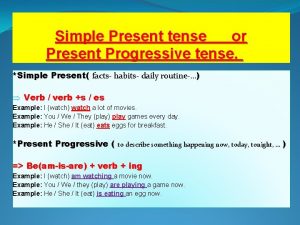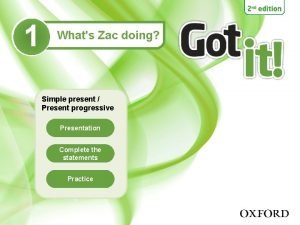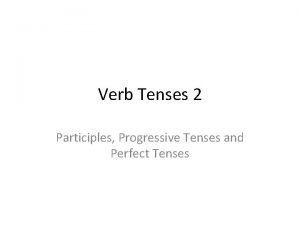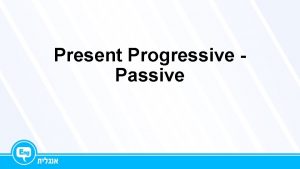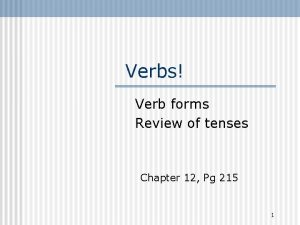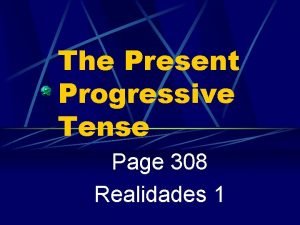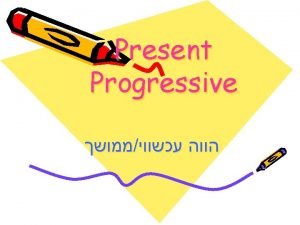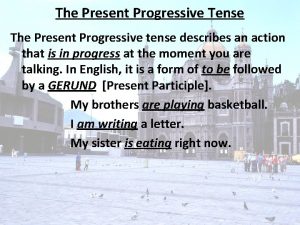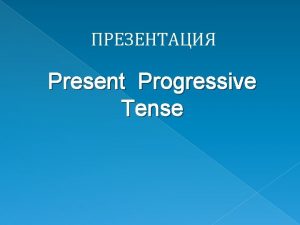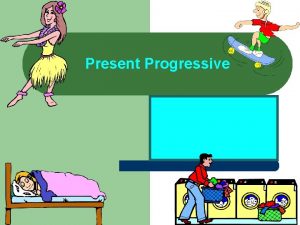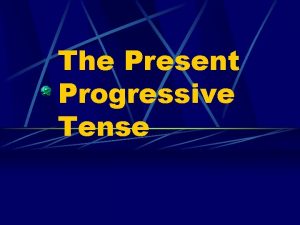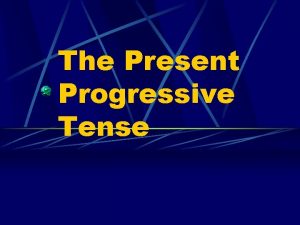Present Progressive Tense Present Progressive Tense The purpose












- Slides: 12

Present Progressive Tense

Present Progressive Tense • The purpose of the Present Progressive Tense is to indicate an action currently in progress/happening right now. It is equivalent to the English translation is/are (doing something). Formation: estar + present participle

Present Progressive Tense Formation of Regular Present Participles INFINITVE STEM ENDING PRESENT PARTICIPLE hablar habl- -ando hablando comer com- -iendo comiendo vivir viv- -iendo viviendo

Present Progressive Tense • The –ando and -iendo endings are equivalent to the –ing suffix in English Ejemplos: Estoy hablando con ella. I am talking/speaking with her. Estamos comiendo enchiladas. We are eating enchiladas. Estás viviendo en un apartamento. You are living in an apartment.

Present Progressive Tense Stem –changes, irregulars and spelling changes • -ir verbs that stem-change in the present tense have a stem-change in the present participle INFINITIVE PRESENT PARTICIPLE decir diciendo dormir durmiendo mentir mintiendo morir muriendo pedir pidiendo sentir sintiendo sugerir sugiriendo preferir prefiriendo

Present Progressive Tense • Irregular Present Participles INFINITIVE PRESENT PARTICIPLE ir *yendo poder *pudiendo sonreír sonriendo reír riendo *yendo and pudiendo are almost never used in the present progressive tense.

Present Progressive Tense • Spelling changes • -er and –ir verbs whose stem end in a vowel will have an i→y spelling change in the present participle -YENDO ENDING construir construyendo leer leyendo oír oyendo traer trayendo incluir incluyendo influir influyendo

Present Progressive Tense Auxiliary verbs other than ESTAR used in the Present Progressive Tense seguir + present participle = to keep doing Laura sigue hablando de su novio. Laura keeps on talking about her boyfriend.

Present Progressive Tense ir + present participle = more and more Vamos disfrutando esta clase cada día. We are enjoying this class more and more everyday.

Present Progressive Tense venir + present participle = been doing (accumulates and increases over time) El empleado viene insistiendo en el plan por varias semanas. The employee has been insisting on the plan for several weeks.

Present Progressive Tense andar + present participle = going around doing/always doing Los alumnos siempre andan quejando de la tarea. The students are always going around complaining about the homework.

Present Progressive Tense ¡Avanzado! The present participle can be used with other tenses: Past Progressive: Yo estaba estudiando cuando el teléfono sonó. I was studying when the phone rang. Future Progressive: Estaremos abordando el avión para Madrid pronto. We will be boarding the plane for Madrid soon.
 Simple present progressive tense
Simple present progressive tense Simple present or present progressive
Simple present or present progressive Relative clause noredink
Relative clause noredink Present progressiv passiv
Present progressiv passiv What is use in past tense
What is use in past tense Tenses chart
Tenses chart Tense chart
Tense chart Simple present tense vs present continuous tense exercise
Simple present tense vs present continuous tense exercise Czas present perfect tense
Czas present perfect tense Present perfect tense vs present perfect continuous tense
Present perfect tense vs present perfect continuous tense Present tense present continuous tense
Present tense present continuous tense Present progressive escribir
Present progressive escribir Past proggresive
Past proggresive
